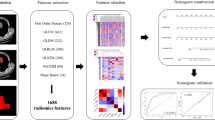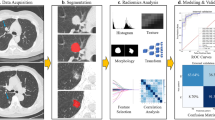Abstract
Objectives
The aim of this study was to develop a radiomics nomogram by combining the optimized radiomics signatures extracted from 2D and/or 3D CT images and clinical predictors to assess the overall survival of patients with non-small cell lung cancer (NSCLC).
Methods
One training cohort of 239 and two validation datasets of 80 and 52 NSCLC patients were enrolled in this study. Nine hundred seventy-five radiomics features were extracted from each patient’s 2D and 3D CT images. Least absolute shrinkage and selection operator (LASSO) regression was used to select features and generate a radiomics signature. Cox hazard survival analysis and Kaplan-Meier were performed in both cohorts. The radiomics nomogram was developed by integrating the optimized radiomics signature and clinical predictors, its calibration and discrimination were evaluated.
Results
The radiomics signatures were significantly associated with NSCLC patients’ survival time. The signature derived from the combined 2D and 3D features showed a better prognostic performance than those from 2D or 3D alone. Our radiomics nomogram integrated the optimal radiomics signature with clinical predictors showed a significant improvement in the prediction of patients’ survival compared with clinical predictors alone in the validation cohort. The calibration curve showed predicted survival time was very close to the actual one.
Conclusions
The radiomics signature from the combined 2D and 3D features further improved the predicted accuracy of survival prognosis for the patients with NSCLC. Combination of the optimal radiomics signature and clinical predictors performed better for individualied survival prognosis estimation in patients with NSCLC. These findings might affect trearment strategies and enable a step forward for precise medicine.
Key Points
• We found both 2D and 3D radiomics signature have favorable prognosis, but 3D signature had a better performance.
• The radiomics signature generated from the combined 2D and 3D features had a better predictive performance than those from 2D or 3D features.
• Integrating the optimal radiomics signature with clinical predictors significantly improved the predictive power in patients’ survival compared with clinical TNM staging alone.






Similar content being viewed by others
Abbreviations
- ANOVA:
-
Analysis of variance
- C-index:
-
The Harrell concordance index
- CCC:
-
Lin’ concordance correlation coefficient
- CT:
-
Computed tomography
- GLRLM:
-
Gray-level run length matrix
- HR:
-
Hazard ratio
- LASSO:
-
Least absolute shrinkage and selection operator
- NSCLC:
-
Non-small cell lung cancer
- Rad-score:
-
Radiomics score
- TNM:
-
Tumor-node-metastasis
References
Siegel RL, Miller KD, Jemal A (2017) Cancer statistics, 2017. CA Cancer J Clin 67:7–30
Ferlay J, Soerjomataram I, Dikshit R et al (2015) Cancer incidence and mortality worldwide: sources, methods and major patterns in GLOBOCAN 2012. Int J Cancer 136:E359–E386
Goldstraw P, Chansky K, Crowley J et al (2016) The IASLC lung cancer staging project: proposals for revision of the TNM stage groupings in the forthcoming (eighth) edition of the TNM classification for lung cancer. J Thorac Oncol 11:39–51
Sculier JP, Chansky K, Crowley JJ, Van MJ, Goldstraw P (2008) The impact of additional prognostic factors on survival and their relationship with the anatomical extent of disease expressed by the 6th edition of the TNM classification of malignant tumors and the proposals for the 7th edition. J Thorac Oncol 3:457–466
Chansky K, Sculier JP, Crowley JJ et al (2009) The international association for the study of lung cancer staging project: prognostic factors and pathologic TNM stage in surgically managed non-small cell lung cancer. J Thorac Oncol 4:792–801
Kawaguchi T, Takada M, Kubo A et al (2010) Performance status and smoking status are independent favorable prognostic factors for survival in non-small cell lung cancer: a comprehensive analysis of 26,957 patients with NSCLC. J Thorac Oncol 5:620–630
Liang W, Zhang L, Jiang G et al (2015) Development and validation of a nomogram for predicting survival in patients with resected non-small-cell lung cancer. J Clin Oncol 33:861–869
Cancer Genome Atlas Research Network (2014) Comprehensive molecular profiling of lung adenocarcinoma. Nature 511:543–550
Gutman DA, Cooper LA, Hwang SN et al (2013) MR imaging predictors of molecular profile and survival: multi-institutional study of the TCGA glioblastoma data set. Radiology 267:560–569
Ellison G, Zhu G, Moulis A, Dearden S, Speake G, McCormack R (2013) EGFR mutation testing in lung cancer: a review of available methods and their use for analysis of tumour tissue and cytology samples. J Clin Pathol 66:79–89
Chen Z, Fillmore CM, Hammerman PS, Kim CF, Wong KK (2014) Non-small-cell lung cancers: a heterogeneous set of diseases. Nat Rev Cancer 14:535–546
Aerts HJ, Velazquez ER, Leijenaar RT et al (2014) Decoding tumour phenotype by noninvasive imaging using a quantitative radiomics approach. Nat Commun 5:4006
Lambin P, Rios-Velazquez E, Leijenaar R et al (2012) Radiomics: extracting more information from medical images using advanced feature analysis. Eur J Cancer 48:441
Gillies RJ, Kinahan PE, Hricak H (2016) Radiomics: images are more than pictures, they are data. Radiology 278:563–577
Guo W, Li H, Zhu Y et al (2015) Prediction of clinical phenotypes in invasive breast carcinomas from the integration of radiomics and genomics data. J Med Imaging (Bellingham) 2:041007
Choi ER, Lee HY, Jeong JY et al (2016) Quantitative image variables reflect the intratumoral pathologic heterogeneity of lung adenocarcinoma. Oncotarget 7:67302
Parmar C, Leijenaar RT, Grossmann P et al (2015) Radiomic feature clusters and prognostic signatures specific for lung and head & neck cancer. Sci Rep 5:11044
Zhang B, Tian J, Dong D et al (2017) Radiomics features of multiparametric MRI as novel prognostic factors in advanced nasopharyngeal carcinoma. Clin Cancer Res 23:4259
Huang Y, Liu Z, He L et al (2016) Radiomics signature: a potential biomarker for the prediction of disease-free survival in early-stage (I or II) non-small cell lung cancer. Radiology 281:947
Hawkins SH, Korecki JN, Balagurunathan Y et al (2014) Predicting outcomes of nonsmall cell lung cancer using CT image features. IEEE Access 2:1418–1426
Zhang Y, Oikonomou A, Wong A, Haider MA, Khalvati F (2017) Radiomics-based prognosis analysis for non-small cell lung cancer. Sci Rep 7:46349
Win T, Miles KA, Janes SM et al (2013) Tumor heterogeneity and permeability as measured on the CT component of PET/CT predict survival in patients with non-small cell lung cancer. Clin Cancer Res 19:3591
Clark K, Vendt B, Smith K et al (2013) The Cancer Imaging Archive (TCIA): maintaining and operating a public information repository. J Digit Imaging 26:1045–1057
Galloway MM (1975) Texture analysis using gray level run lengths. Comput Graph Image Process 4:172–179
Meinshausen N, Bühlmann P (2006) High-dimensional graphs and variable selection with the Lasso. Ann Statist 34:1436–1462
Therneau TM, Grambsch PM (2000) Modeling survival data: extending the cox model. Springer-Verlag, New York
Collins GS, Reitsma JB, Altman DG, Moons KG (2015) Transparent reporting of a multivariable prediction model for individual prognosis or diagnosis (TRIPOD): explanation and elaboration. Eur J Clin Invest 45:204–214
Sauerbrei W, Boulesteix AL, Binder H (2011) Stability investigations of multivariable regression models derived from low- and high-dimensional data. J Biopharm Stat 21:1206–1231
Parmar C, Grossmann P, Bussink J, Lambin P, Aerts HJ (2015) Machine learning methods for quantitative radiomic biomarkers. Sci Rep 5:13087
Shen C, Liu Z, Guan M et al (2017) 2D and 3D CT radiomics features prognostic performance comparison in non-small cell lung cancer. Transl Oncol 10:886–894
Funding
This study has received funding by the National Key Research and Development Program of China (Grant No. 2017YFA0205202) and partially funded by the National Natural Science Foundation of China (Grant No. U1401255 and 61672422).
Author information
Authors and Affiliations
Corresponding authors
Ethics declarations
Guarantor
The scientific guarantor of this publication is Liyu Huang.
Conflict of interest
The authors of this manuscript declare no relationships with any companies, whose products or services may be related to the subject matter of the article.
Statistics and biometry
Jun Li kindly provided statistical advice for this manuscript.
Informed consent
Written informed consent was not required for this study because the data were obtained from the collection of NSCLC-Radiomics in The Cancer Imaging Archive (TCIA, URL: http://www.cancerimagingarchive.net/).
Ethical approval
Institutional Review Board approval was not required because the data were obtained from the collection of NSCLC-Radiomics in The Cancer Imaging Archive (TCIA, URL: http://www.cancerimagingarchive.net/). It is a public database and we added the reference of data in our study.
Methodology
• retrospective
• diagnostic or prognostic study
• multicenter study
Electronic supplementary material
ESM 1
(DOC 1259 kb)
Rights and permissions
About this article
Cite this article
Yang, L., Yang, J., Zhou, X. et al. Development of a radiomics nomogram based on the 2D and 3D CT features to predict the survival of non-small cell lung cancer patients. Eur Radiol 29, 2196–2206 (2019). https://doi.org/10.1007/s00330-018-5770-y
Received:
Revised:
Accepted:
Published:
Issue Date:
DOI: https://doi.org/10.1007/s00330-018-5770-y




